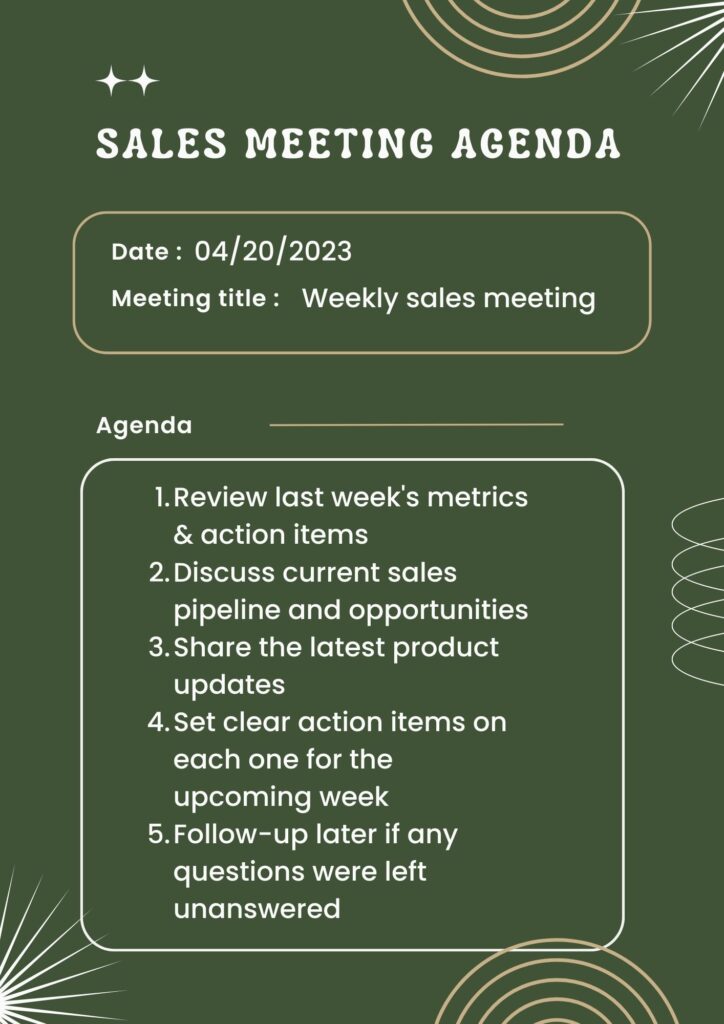
“How to run a sales meeting under 20 minutes?”
You should’ve asked this to Google an unhealthy number of times by now 😅 We know because we’ve been there.
Let’s face the truth: sales meetings that go beyond 20 minutes can be a drag. They can eat up valuable time and leave your team feeling more drained than a marathon runner at the finish line.
The good news is that with a little bit of pre-planning, you can conduct a sales meeting that is not only effective but also won’t have your team checking their watches every five minutes.
In this article, you will learn how to run a sales meeting in under 20 minutes that will keep your team engaged, productive, and motivated to close deals.
5 tips for conducting high-impact sales meetings
Before diving into how to run a sales meeting in under 20 minutes, it’s essential to pre-plan the meeting effectively to maximize its impact.
Planning ahead can ensure that the meeting stays on track, covers all necessary topics, and results in actionable next steps.
Here are 5 ways to help you make your meeting successful –
1. Start with the end in mind
When you’re planning a sales meeting, it’s crucial to start by defining the meeting’s objective and desired outcome.
Without a clear objective, you risk having a meeting that goes off track or fails to achieve its intended purpose. This is because there’s always a lot to talk about – pipeline, opportunities, weekly goals, monthly goals, and the list never ends.
To define the meeting’s objectives, ask yourself, “What do I want to accomplish by the end of the meeting?” Your objective should be SMART – Specific, Measurable, Achievable, Relevant, and Time-bound.
For example, your objective could be to review the progress of your top sales deals for the quarter and identify any roadblocks or opportunities to accelerate the deals.
Once you’ve defined the objective, you can work backward to structure the meeting to achieve that objective.
2. Structured sales meeting agenda
You and your peers should know what should be achieved in these 20 minutes and having a plan or outline of the topics to be discussed during the meeting can immensely help your team.
It will provide a clear roadmap for the meeting and ensure that the discussion stays focused and on track.
You have to be specific and concise about these topics. A well-structured sales meeting agenda should only have the high-level details.
Most importantly, you should list them in the order in which they will be discussed. So, make sure to prioritize the most critical ones first and always leave some time unplanned for last-minute conversations that your team might want to share.
Once you have the agenda ready, share it with the team in advance, ideally at least a day before the meeting. This gives everyone a chance to prepare and understand what will be discussed during the meeting.
This will also help them identify any potential roadblocks or issues that they may want to bring up during the meeting. This can lead to a more productive and engaging discussion.
3. Stay on topic
For running effective sales meetings, it’s essential not only to create clear objectives and an agenda but also to stick to them.
You must stay focused throughout the meeting, ensuring if everyone is following the agenda.
If the conversation deviates, politely redirect the discussion back to the topic at hand. Acknowledge any valuable contributions and let the team know that you will follow up after the meeting.
Make sure you take notes – whenever new topics or questions come up during the meeting, take note of them and suggest discussing them during a separate meeting or follow-up discussion.
This will help keep the current meeting on track and prevent it from getting sidetracked.
And don’t forget to follow-up with the respective members once the meeting is over and provide answers to any questions that were asked during the meeting.
4. Encourage participation
You should prepare yourself to connect with your teammates on a real level. Be energetic and show interest towards your teammates’ inputs and ideas.
Ask open-ended questions instead of asking yes or no questions. This is a great way to encourage discussion and allow team members to share their opinions.
Avoid interrupting them! Listen actively when your teammates are speaking. Focus on what they are saying and respond only when they are completely done with sharing their thoughts.
This way, you create a safe space for discussion where everyone feels comfortable and wants to contribute to the conversation.
5. Set action items
The ultimate goal of a sales meeting is to move closer to achieving your sales objectives. Therefore, it’s crucial to set actionable next steps in the meeting that would drive your team to focus on the goal and you can review them again at your next meeting.
These actionable steps must be clear and specific to each member of your team. Be sure to assign well-defined tasks, including what needs to be done, who is responsible for completing them, and when they need to be done.
For every task, communicate with the owner who’s going to work on it and ask them to establish clear deadlines. If you feel like they are taking too much time or less time to complete a task, communicate accordingly and set expectations.
You can check in with them once in a while on how they progress but do not micro-manage. You need to trust your teammates and be empathetic.
Breakdown of how to run a sales meeting under 20 minutes
Running effective sales meetings require careful planning and execution especially when you intentionally want to keep it under 20 minutes.
Remember you are not the only person here spending 20 minutes. It’s 20 minutes multiplied by the number of members in your team.
If you are a sales team of 4 including you and if you are not having an objective behind this meeting, you are wasting 80 minutes!!!
Therefore, be prepared and ensure that you are making the most of everybody’s time.
Here’s a breakdown of running a weekly sales meeting under 20 minutes –
I. Introduction – 5 minutes
To begin with, you should set the tone for the meeting and create a productive and engaging environment.
Obviously, you should start the meeting with a friendly greeting and make sure everyone feels welcome. This is an opportunity to make a personal connection with your team members and help them feel at ease.
Next, explain the purpose and goal of the meeting. Make sure your team knows exactly what you hope to achieve during this time together. Be clear about the objective and the outcome you’re hoping for.
Quickly review the agenda that you prepared and shared with your team. Briefly go over each topic and let your team know what to expect. This will help keep everyone on track and focused during the meeting.
The entire introduction should take no more than 5 minutes because you would’ve shared the high-level agenda to your team already.
If you haven’t, you should definitely share it. It helps everyone to stay focused on the outcome of the meeting which means less deviation.
II. Progress towards sales targets – 10 minutes
This is the major part of the meeting. This is the time you focus on all things sales that need to be addressed in this sales meeting.
You should gather information on the following in these 10 minutes –
1. Review previous week’s action items and metrics
Discuss the results from the previous week’s sales efforts. Start by reviewing the action items assigned to each team member during the last meeting and determine if they were accomplished.
Then, share the sales metrics, such as revenue, number of meetings booked by each SDR, number of deals closed, and the conversion rate.
If you are still figuring out what metrics to track, you should check out this article on the top sales KPIs to track with free templates.
2. Discuss current sales pipeline and opportunities
Go through each opportunity in the pipeline and discuss its status, next steps, and potential roadblocks.
This discussion should help identify any opportunities that need additional attention and support from the team.
Encourage the team members to share their insights and opinions, and ask open-ended questions to encourage participation.
At the end of this segment, you should be able to answer the following –
- What does the current pipeline look like?
- How many opportunities can be converted to deals in the upcoming week?
3. Share the latest product feature releases and updates
As a salesperson, staying up-to-date on the latest product releases and updates is essential. Take a couple of minutes to share the latest product feature releases and updates that can help the team in their sales efforts.
This allows the team to stay updated on what’s happening with the product and they can communicate the product’s benefits and address any questions confidently that the potential customers may have and conduct product demos more effectively.
III. Closing – 5 minutes
Last but not least: the grand finale!
This is where you wrap up the meeting and ensure that everyone is on the same page.
Take a minute to summarize the key takeaways from the meeting. Then, assign action items and deadlines to team members to make sure that the meeting results in actionable next steps.
Finally, allow time for questions and feedback, so that everyone has a chance to voice their thoughts and concerns. This will help to ensure that the meeting is productive and that everyone is clear on what they need to do next.

And with that, your sales meeting comes to a successful close. Mic drop.

Final thoughts
Remember, time is money – especially in sales!
Whether you’re a nimble startup or a well-oiled sales machine, a quick and effective sales meeting can work wonders for your bottom line. But don’t get too caught up on the 20-minute timeframe – after all, Rome wasn’t built in a day, and neither is a killer sales team.
The size of your team and its needs will determine the frequency and duration of your meetings, so don’t be afraid to adjust accordingly.
Just make sure you have a clear agenda, actionable next steps, and plenty of coffee.
With a bit of planning, a touch of wit, and a whole lot of hustle, you can lead your team to sales glory – one meeting at a time.